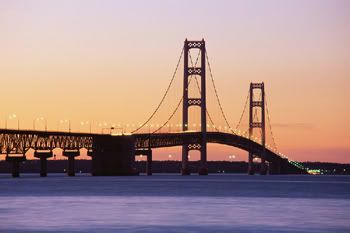


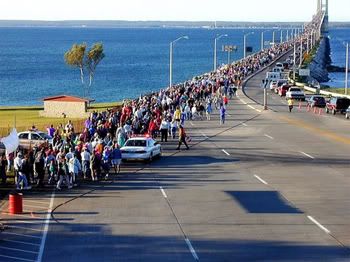
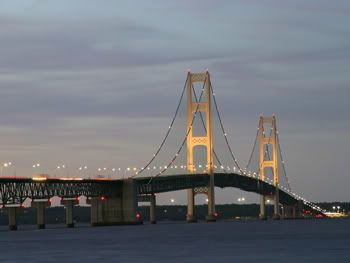
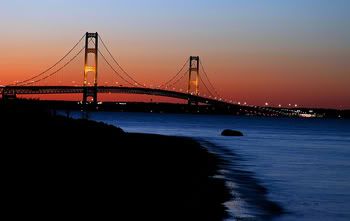
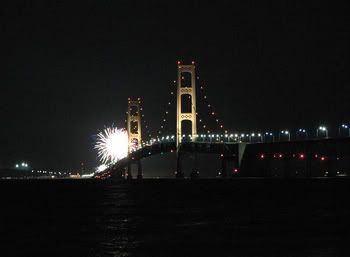
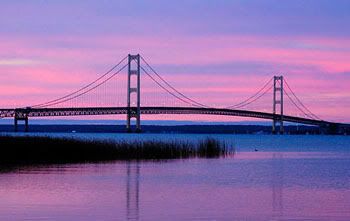
Over on Obscure History is a great post on The Second Narrows Bridge Collapse, and as I was reading it, I realized that one bridge that is always conspicuously missing from any Science or Discovery Channel Documentary on Suspension Bridges is The Mackinac Bridge, which is five miles long and connects the Upper and Lower Peninsulas of Michigan together. So while I know all of you are familar with what the Golden Gate Bridge in San Francisco looks like, I thought I'd showcase for you today pictures of my personal favorite bridge, and tell you a little bit about it.
The Mackinac Bridge (pronounced /ˈmækɨnɔː/, with a silent "c" at the end of the word), is a suspension bridge spanning the Straits of Mackinac. Envisioned since the 1880s, the bridge was completed only after many decades of struggles to begin construction. Designed by engineer David B. Steinman, the bridge (familiarly known as "Big Mac" and "Mighty Mac") connects the city of St. Ignace on the north end with the village of Mackinaw City on the south. It is the longest suspension bridge between anchorages.
The bridge opened on November 1, 1957, ending decades of the two peninsulas being solely linked by ferries. A year later, the bridge was formally dedicated as "the world's longest suspension bridge between anchorages". This designation was chosen because the bridge would not be the world's largest using another way of measuring suspension bridges, the length of the center span between the towers; at the time that title belonged to the Golden Gate Bridge, which has a longer center span. By saying "between anchorages", the bridge could be considered longer than the Golden Gate Bridge, and also longer than the suspended western section of the San Francisco-Oakland Bay Bridge. (That bridge has a longer total suspension but is a double bridge with an anchorage in the middle.)
The Mackinac Bridge is the longest suspension bridge with two towers between anchorages (8,614 feet) in the Western Hemisphere. Much longer anchorage-to-anchorage spans have been built in the Eastern Hemisphere, including the Akashi-Kaikyo Bridge in Japan (12,826 feet). However, because of the long leadups to the anchorages on the Mackinac, from shoreline to shoreline it is much longer than the Akashi-Kaikyo (5 miles compared to 2.4 miles).
The length of the bridge's main span is 3,800 feet (1,158 m), which makes it the third-longest suspension span in the United States and twelfth longest worldwide.
HISTORY
The Algonquin Native Americans called the straits and the surrounding area "Michilimackinac," meaning "the jumping-off place" or "great road of departure." These Native Americans moved around the straits rather than crossing them. The straits were the end of the trail.
As Europeans settled in the area, the straits became an important area for trade and commerce. The clean air, abundant fish and beautiful views attracted people from all over the area to the straits. Still, the only way to cross was by ferry.
Typically, a fleet of nine ferries could carry up to 9,000 vehicles per day. Traffic backups sometimes stretched to Cheboygan, Michigan, 16 miles away from Mackinaw City. Year-round boat service across the straits had been abandoned as impractical because of the cold winters which would often freeze the water across the entire strait. Following the opening of the Brooklyn Bridge in 1883, local residents began to imagine such a structure could span the straits. In 1884, a store owner in St. Ignace published a newspaper advertisement that included a reprint of an artist's conception of the Brooklyn Bridge with the caption "Proposed bridge across the Straits of Mackinac."
The idea of the bridge was discussed in the Michigan Legislature as early as the 1880s. At the time the area was becoming a popular tourist destination, including the creation of Mackinac National Park on Mackinac Island in 1875.
Despite the perceived necessity for the bridge, several decades went by with no formal plan. In 1920, the Michigan state highway commissioner advocated the construction of a floating tunnel across the straits. At the invitation of the state legislature, C. E. Fowler of New York City put forth a plan for a long series of causeways and bridges across the straits from Cheboygan, 17 miles southeast of Mackinaw City, to St. Ignace, using Bois Blanc, Round, and Mackinac Island as intermediate steps.
In 1923, the state legislature ordered the State Highway Department to establish ferry service across the strait. More and more people used ferries to cross the straits each year, and as they did, momentum to create a bridge grew even stronger. Chase Osborn, a former governor, wrote, "Michigan is unifying itself, and a magnificent new route through Michigan to Lake Superior and the Northwest United States is developing, via the Straits of Mackinac. It cannot continue to grow as it ought with clumsy and inadequate ferries for any portion of the year."
By 1928 the ferry service had become so popular and so expensive to operate that Michigan Governor Fred Green ordered the department to study the feasibility of building a bridge across the strait. The department deemed the idea feasible, estimating the cost at 30 million dollars.
In 1934, the Michigan Legislature created the Mackinac Straits Bridge Authority of Michigan, to explore possible methods of constructing and funding the bridge. The Legislature authorized the Authority to sell bonds for the project. In the mid 1930s, the Authority twice attempted to obtain federal funds for the project but was unsuccessful, despite the endorsement of the United States Army Corps of Engineers and President Franklin D. Roosevelt. Nevertheless, between 1936 and 1940, a route was selected for the bridge and borings were made for a detailed geological study of the route.
The preliminary plans for the bridge featured a 3-lane roadway, a railroad crossing on the underdeck of the span, and a center-anchorage double-suspension bridge configuration similar to the design of the San Francisco-Oakland Bay Bridge. Since this would have required sinking an anchorage pier in the deepest area of the Straits, the practicality of this design may have been questionable. A causeway, approximately 4,000 feet, extending from the northern shore, was constructed with concrete road fragments from 1939-1941.
At that time, with funding for the project still uncertain, further work was put on hold because of World War II. The Authority was abolished by the state legislature in 1947 but was reauthorized three years later in 1950. In June 1950, engineers were retained for the project. Following a report by the engineers in January 1951, the state legistature authorized the sale of 85 million dollars in bonds for bridge construction on April 30, 1952. However, a weak bond market in 1953 forced a delay of over a year before the bonds could be issued.
ENGINEERING AND CONSTRUCTION
David B. Steinman was appointed as the design engineer in January 1953. By the end of 1953, estimates and contracts had been negotiated, and construction began on May 7, 1954. The American Bridge Division of United States Steel Corporation was awarded a contract of over 44 million dollars to build the steel superstructure.
Construction took three and a half years (4 summers, no winter construction) and cost the lives of five men who worked on the bridge. It opened to traffic on schedule on November 1, 1957, and was formally dedicated on June 25, 1958. The bridge officially achieved its 100 millionth crossing exactly forty years after its dedication, on June 25, 1998. The 50th anniversary of the bridge's opening was celebrated in a ceremony hosted by the Mackinac Bridge Authority at the viewing park adjacent to the St. Ignace causeway on November 1, 2007.
The design of the Mackinac Bridge was directly influenced by the lessons of the first Tacoma Narrows Bridge, which failed in 1940 because of its instability in high winds. Three years after that disaster, Steinman had published a theoretical analysis of suspension bridge stability problems which recommended that future bridge designs include deep stiffening trusses to support the bridge deck and an open-grid roadway to reduce its wind resistance. Both of these features were incorporated into the Mackinac Bridge. The stiffening truss is open to reduce wind resistance. The road deck is shaped as an airfoil to provide lift in a cross wind, while the center two lanes are open grid to allow vertical (upward) air flow, which fairly precisely cancels the lift, making the roadway stable in design in winds up to 150 m.p.h.
FACTS AND FIGURES
The Mackinac Bridge is currently a toll bridge on Interstate 75. Prior to the coming of I-75, the bridge carried US 27. It is one of only two segments of I-75 that is tolled; the other is Alligator Alley in Florida.
The current toll is US$3.00 for automobiles and $3.50 per axle for trucks. The current Toll was increased March 1, 2008 from $2.50 US for Cars. The Mackinac Bridge Authority has proposed raising the rate to $4 for cars and $5 per axle for trucks to fund a $300 million renovation program, which would include completely replacing the bridge deck.
Every Labor Day, two of the lanes of the bridge are closed to traffic and open to walkers for the Mackinac Bridge Walk.
Painting of the bridge takes seven years, and when painting of the bridge is complete, it begins again.
Overall length shore to shore: 26,372 feet or approximately 5 miles.
Length from cable bent pier to cable bent pier: 7,400 feet.
Total width of the roadway: 54 feet
Two outside lanes: 12 feet wide each
Two inside lanes: 11 feet wide each
Center mall: 2 feet
Catwalk, curb and rail width: 3 feet on each side
Width of stiffening truss in the suspended span: 68 feet, making it wider than the roadway it supports.
Height of the roadway at mid-span: approximately 200 feet above water level.
Vertical clearance at normal temperature:
155 feet at the center of the main suspension span.
135 feet at the boundaries of the 3,000 feet wide navigation channel.
Construction cost: $99.8 million (1957 USD; adjusted for inflation, approximately $732 million, 2007 USD)
Height of towers above water: 552 feet
Max. depth of towers below water: 210 feet
Total length of wire in main cables: 42,000 miles
Total vehicle crossings, 2005: 4,236,491 (average 11,608 per day)
Speed limit: 45 mph for passenger cars, 20 mph for heavy trucks. Heavy trucks are also required to leave 500 feet spacing ahead.
Thanks for reading.
Technorati Tags: mackinac bridge, straits of mackinac, michigan, great lakes, lake michigan, lake huron, upper peninsula, lower peninsula, suspension bridges
Generated By Technorati Tag Generator















11 comments:
Hi Matt,
Even though I have never been across this bridge my husband has many times as a driver.
I have heard him tell of it often. He says it is truly spectacular and you have some great shots here!!
Thanks for sharing!
Can I please ask you a favor? You seem to understand how EC works so well and I am having one particular problem.
I cannot figure out how to locate people that I would like to buy adds from.
Is the only way to do a search under campaign?
I have tried that so many times and no matter what name or address I put in for the blog it always comes back with a cannot find answer.
Can you please help me with this? Pretty please?
Thanks in advance if you can!!:-)))
Stunning photos of the bridge...great post...cheers
hi, you have many adversts including payperpost and still quite good google page ranking, whats the trick, my blog lost ranking immediately i signed up to ppp?how unfortunate-and its not about the content,backlinks etc-that you can agree with me!
Beautiful shots of the bridge! Love your blog!
Amazing pictures.
Visit my entry too for this week :)
no matter how many times I crossed it..it was always fascinating..one of the things to see in life
Beautiful, yes. Almost wordless? NO! But you got my Battle of the Blogs vote anyway...thanks for your vote for the Hottest Mommy Blogger award.
Roxy
Wow, simply breath taking! I love this bridge and I've never been. Thank YOU for taking me there. :)
Fabulous post! I always wanted to get up north and drive across that bridge, we never made it though and now we live too far down south. Maybe someday. Thanks for posting the beautiful pictures too.
Those are great pictures. My one fear is bridges. I try to avoid them.
Isn't today the day we've all been waiting for?
Roxy
Post a Comment